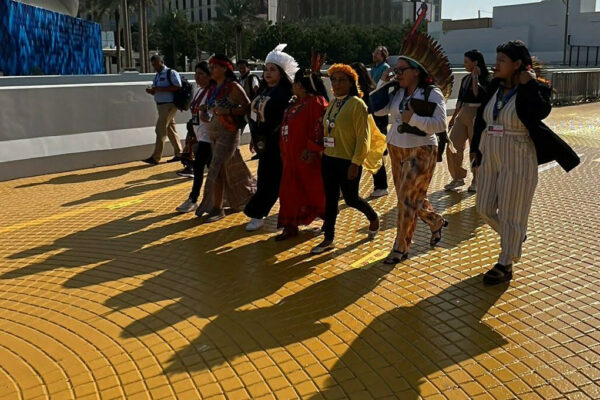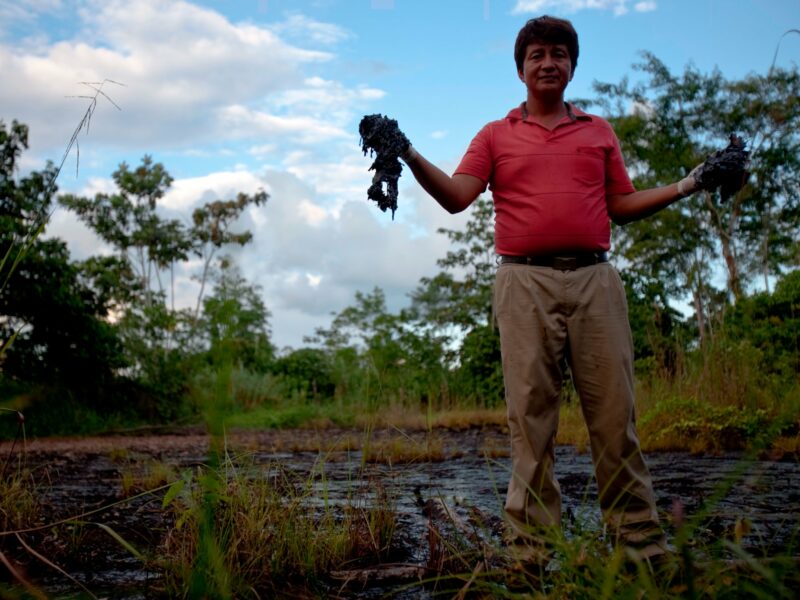San Ramon — Humberto Piaguaje and Carmen Perez traveled thousands of miles from their native Ecuador to see a wall of pictures on display in San Ramon.
Piaguaje, an indigenous Secoya, and Perez, an Ecuadorean public health worker, were on hand Monday night for the opening of an art exhibit titled “Crude Reflections: ChevronTexaco’s Rain Forest Legacy.” The 52-picture expose by Bay Area photographers Lou Dematteis and Kayana Szymczak documents the suffering of indigenous people from contamination to the Amazon rain forest.
The visitors hope their presence and the photo exhibit will bring attention to their people’s struggle instead of being seen as a smear campaign against the oil giant headquarted in San Ramon.
“My message to people who couldn’t make it to the exhibit: Don’t feel bad about our presence here,” the soft- spoken Piaguaje said in Spanish through an interpreter. “It’s not about damaging the image of ChevronTexaco. Instead, we are trying to make them understand that human life is in danger.”In 1993, residents of Ecuadors Oriente region filed a class-action lawsuit against ChevronTexaco in a New York federal court. The trial was eventually moved to an Ecuadorean court.
The plaintiffs claim that Texaco, which drilled for oil in the Ecuadorean Amazon from 1974 to 1990, before merging with Chevron in 2001, polluted 11,000 acres of soil and groundwater, causing a wide range of sicknesses in the five indigenous peoples living in the area. The sicknesses range from cancer to skin irritations to urinary infections, said Perez, who added some of the conditions can be partially treated but not cured.
A ChevronTexaco news release said there was no credible evidence to justify the claims of the lawsuit and noted that Texaco spent $40 million to clean up more than 250 sites to ensure there would be no lasting environmental impact. The three-year program, completed in 1998, was conducted under an agreement with Ecuadorian government.
Still, one of the lawyers for the plaintiffs, Steven R. Donzinger, said the cleanup was not done properly. Regardless, Piaguaje simplly wants his peoples land cleaned up so they can survive. If something is not done soon, the Secoya, which has seen its population decrease significantly over the years, will become extinct, he said.
I hope he, David OReilly (ChevronTexaco CEO), hears the cries of our people, because in just a few years we are all going to die, he said. There are just a few of us. I hope they take that to heart. Its not that we want money. We never had it. We want life. We want clean water.
For the photographers, the exhibit was an opportunity to learn and share the stories of the indigenous Ecuadorians. Szymczak said she received clearance from the locals and told them she was planning on doing an exhibit before traveling to Ecuador. Last February, she spent five weeks in the rain forest with the indigenous people documenting their stories.
(They) saw me and this event as a vehicle to promote what was happening, she said. This event gives them a voice.
On her trip, Szymczak had experiences she will keep with her for life. On her first day in Ecuador, Szymczak met Jose and Celia Mashumar. The couple, whose two teenage daughters died of cancer, showed Szymczak their backyard where they said Texaco had come and without their permission started drilling for oil on their land.
Its so hot and the fumes were so strong that it was hard to breath, she said. I found myself wondering spontaneously (if) being here one day (will) have long-term effects on me. After that first day, I left in awe of how bad it really is.
Donziger hopes the exhibit and the Ecuadorians presence in the Bay Area can help build a bridge and bring both sides together to find a solution.
There does not have to be antagonism between the leaders of the indigenous people and ChevronTexaco, he said.
The exhibit will be on display through Thursday at Mudds Restaurant, 10 Boardwalk, in San Ramon or viewed online at www.amazonwatch.org.
Sajid Farooq covers San Ramon and Dublin for the Herald. He can be reached at (925) 416-4813 or sfarooq@angnewspapers.com
http://www.insidebayarea.com/searchresults/ci_2684968













